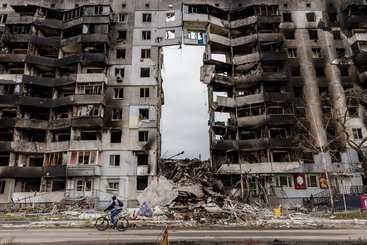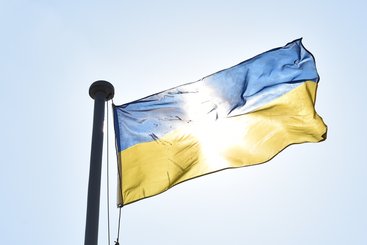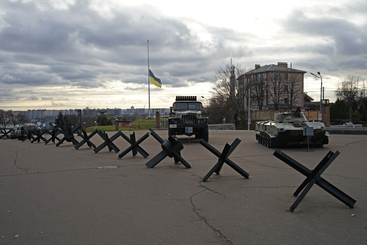Cascading risks stemming from Russia’s war with Ukraine have created shocks to long-standing global peace and security arrangements whose durability was long taken for granted.
As the war continues, Olena Borodyna, Senior Geopolitical Transition Risks Advisor in ODI’s Global Risk and Resilience programme, highlights three key geopolitical risks to watch in 2024.
1. Russia scales up its wartime economy as dissent remains limited
Russia is prepared to maintain military action for the foreseeable future as its troops dig in at the frontline. The country has scaled up its defence sector budget by around 70% this year, meaning that defence now accounts for almost 30% of its federal budget for 2024. While the economy has come under pressure from sanctions, export controls and other tools utilised by Ukraine’s allies, it has not collapsed and is expected to grow at a rate of around 1% in 2024. In the meantime, the country’s oil exports are being sold outside the price cap imposed by the G7 nations, facilitated by its shadow fleet of oil tankers. President Putin anticipates that elections, escalating conflict elsewhere, public weariness and domestic political infighting will wear down financial and military support to Ukraine.
In 2024 Russia will hold a largely symbolic presidential election, which President Putin is most likely to win in the absence of credible opposition, paving the way for another six-year term in power. Large-scale protests against the war and open dissent towards the regime remain limited. Nevertheless, Russia’s Central Bank has focused on controlling inflation ahead of the election as food prices have skyrocketed. The country has carried out several waves of mobilisation and recruitment due to the staggering human costs of the war. Whether these losses translate into political action remains to be seen.
In terms of foreign relations, Russia’s diplomatic engagement with the United States and Europe is at its lowest ebb since the fall of the Soviet Union. But the country is still far from isolated and there is a clear appetite for engagement, as evidenced by President Putin’s trips to China, the United Arab Emirates and Saudi Arabia in 2023. Russia’s continued foreign policy push across Africa – such as the recent reopening of its Embassy in Burkina Faso where Russian state corporation RosAtom plans to engage on nuclear energy development – shows that Russia’s appetite for winning the hearts, minds and votes of the Global South remains unabated.
2. Ukraine navigates a challenging domestic environment
In 2024, Ukraine will need to navigate an increasingly challenging domestic environment, not least because of the lack of clarity on the future of financial and military assistance from the West.
Since February 2022, Ukrainian society and political parties have rallied around the war effort. However, as the war continues, its costs – in human lives, territory, economic and social capital – are mounting, and funding from its major allies the United States and the European Union is no longer secure. Failure to regain the southeastern territories occupied by Russia – contrary to the high expectations set for the counteroffensive in early 2023 – is fuelling concerns over the duration and the costs of the war that Ukraine is yet to pay to maintain its statehood and restore territorial integrity.
The continued the war in 2024 will create numerous political and social challenges. Ukraine will need to mobilise an estimated 450,000-500,000 new recruits to boost its armed forces. Mobilisation of civilians is a contentious topic and will likely prove unpopular – approving a law to that effect will require President Zelenskyy to expend significant political capital.
At the same time, Ukraine also needs to put more resources into managing social risks, including rehabilitation and integration of soldiers and millions of internally displaced people, and financing public sector wages and expenditure while investing in training new army recruits. Though parliamentary and presidential elections are prohibited while martial law is in place, speculation about the timing of the next parliamentary and presidential elections, and pressure to hold them, will likely grow as losses mount and the war is prolonged.
Navigating such domestic challenges will be critical for Ukraine to maintain political and social stability, but also manage perceptions of its allies. Meanwhile, as election season looms globally, Ukraine also needs to consider and devise a strategy to manage different election outcomes, particularly in the United States.
3. Elections and escalation across global hotspots divert Ukraine allies’ attention
From Taiwan and the United States to India and Indonesia – 2024 is a year of elections. Among Ukraine’s allies, the United States and United Kingdom, as well as Romania and Lithuania, are heading into their respective election seasons. European parliamentary elections will preoccupy the continent’s centrists as they seek to stave off right-of-centre parties from gaining more seats. Though changes to political leadership may not necessarily radically change allies’ policy on Ukraine, as is likely the case if the general election brings the Labour Party to power in the United Kingdom, it will nonetheless distract governments as they fight for political survival and during the transition period.
The 2024 United States presidential election will have an outsized impact on the course of the Russia-Ukraine war. A competitive and polarising presidential campaign will escalate political risks in the United States, where many are disillusioned with the state of democratic institutions. A proportion of the American electorate may refuse to accept election results as legitimate, potentially leading to political instability. To what extent its European NATO allies and Ukraine are prepared to mitigate risks linked to political instability in the United States, or indeed have a strategy to manage different election outcomes remains to be seen.
As well as elections, escalation across other global hotspots, particularly the spillovers of the Israel-Hamas conflict across the Middle East and the Horn of Africa, but also potential tensions in the Indo-Pacific around the Taiwan election, all risk diverting the attention of Ukraine’s allies. Russia has already used escalating tensions in the Middle East in the aftermath of Hamas’ attack on Israel to ramp up military pressure on Ukraine.
ODI on the Russia-Ukraine war
Explore more research, commentary and events on the latest developments in the region.




